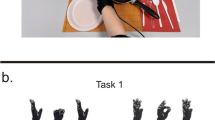Abstract
This paper proposes a computational model for different aspects of trajectory formation, from point-to-point movements to handwriting. The proposed model is based on a mechanism of composition of basic curve elements (strokes) which separates the spatial and the temporal aspects of trajectory formation. At the same time, the model suggests a method for storing and describing arm movements, as a list of stroke descriptors. Experimental trajectories were digitized and analyzed with regard to several types of movements: i) point-to-point trajectories, ii) closed trajectories, iii) trajectories with inflection points, iv) spiral-like trajectories, v) handwritten trajectories. Velocity and curvature profiles were computed for the trajectories and the model was fitted to the data. The implications of the model and its “credibility” in the general context of motor control are discussed.
Similar content being viewed by others
References
Abend, W., Bizzi, E., Morasso, P.: Human arm trajectory formation. Brain105, 331–348 (1982)
Arbib, M.A.: Artificial Intelligence and brain theory: unities and diversities. Ann. Biomed. Eng.3, 228–274 (1978)
Benati, M., Gaglio, S., Morasso, P., Tagliasco, V., Zaccaria, R.: Anthropomorphic robotics. I. Representing mechanical complexity. Biol. Cybern.38, 125–140 (1980)
Benati, M., Morasso, P., Tagliasco, V.: The inverse kinematic problem for anthropomorphic manipulator arms. Trans. ASME, J. Dyn. Syst. Measur. Cont. (in press)
Bernstein, N.: The coordination and regulation of movements. London: Pergamon Press 1967
Boor, C. de: A practical guide to splines. Berlin, Heidelberg, New York: Springer 1978
Crane, H.D., Savoie, R.E.: An on-line data entry system for handprinted characters. Computer, March 43–50 (1977)
Denier van der Gon, J.J., Thuring, J.Ph.: The guiding of human writing movements. Kybernetik2, 145–148 (1965)
Eden, M.: Handwriting generation and recognition. In: Kolers, P.A., Eden, M. (eds.). Recognizing patterns, pp. 138–154. Cambridge, Mass.: MIT Press 1968
Eshkol, N., Wachman, A.: Movement notation. Weidenfeld and Nicolson (1958)
Faux, I.P., Pratt, M.J.: Computational geometry for design and manufacture. Chichester (West Sussex): Ellis Horwood Ltd 1979
Galen, G.P. van: Handwriting and drawing: a two stage model of motor behaviour. In: Stelmach, G.E., Requin, J. (eds.). Tutorials in motor behaviour, pp. 567–578. Amsterdam: North-Holland 1980
Gelfand, I.M., Gurfinkel, V.S., Tsetlin, M.L.: Models of the structural-functional organisation of certain biological systems. Cambridge, Mass: MIT Press 1971
Golani, I.: Homeostatic motor processes in mammalian interactions a choreography of display. In: Bateson, P.P., Kofler, P.H. (eds.). Perspective in ethology. Vol. 2. New York: Plenum Press 1976
Goodnow, J.J., Levine, R.A.: The grammar of action: sequence and syntax in children's copying. Cogn. Psychol.4, 82–98 (1973)
Greene, P.H.: Problems of organisation in motor systems. In: Rosen, R., Snell, F.M. (eds.). Progress in theoretical biology, Vol. 2. New York: Academic Press 1972
Herbst, N.M., Liu, C.N.: Automatic signature verification based on accelerometric data. I.B.M. J. Res. Develop., May, 245–253 (1977)
Hofsten, C. von: Predictive reaching for moving objects by human infants. J. Exp. Child Psychol.30, 369–382 (1980)
Hogan, N.: Mechanical Impedance Control in assistive devices and manipulators. Proc. Joint Autom. Control Conf.1, TA10-B (1980)
Hollerbach, J.M.: An oscillation theory of handwriting. Biol. Cybern.39, 139–156 (1981)
Hutchinson, A.: Labanotation. New York: Theater Arts Books 1970
Katz, D.: Gestalt Psychology. London: Methuen 1951
Lashley, K.S.: The problem of serial order in behaviour. In: Jeffress, L.A. (ed.): Cerebral mechanisms in behaviour, pp. 112–146. New York: Wiley 1951
Lansdown, J.: The computer in choreography. Computer, August, 19–30 (1978)
Marr, D.: Early processing of visual information. Trans. R. Soc. (London)275, 483–524 (1976)
Marr, D., Hildreth, E.: Theory of edge detection. A.I. Memo N. 518 (1979)
Marr, D., Poggio, T.: A computational theory of human stereo vision. Proc. R. Soc. (London)204, 301–328 (1979)
Marr, D.: Visual information processing: the structure and creation of visual representation. Philos. Trans. R. Soc. (London)290, 199–218 (1980)
Mermelstein, P., Eden, M.: Experiments on computer recognition of connected handwritten words. Inf. Cont7, 225–270 (1964)
Morasso, P.: Spatial control of arm movements. Exp. Brain Res.42, 223–227 (1981)
Morasso, P., Mussa Ivaldi, F.A.: Un modele de generation des mouvements d'écriture. Journees Thematiques, Forum Espace III, Position et Mouvements, Marseille (1981)
Polit, A., Bizzi, E.: Characteristics of the motor programs underlying arm movements in monkeys. J. Neurophysiol.42, 183–144 (1979)
Sutherland, N.S.: The representation of three-dimensional objects. Nature278, 395–398 (1974)
Teulings, H.L.H.M., Thomassen, A.J.W.M.: Computer aided analysis of handwriting movements. Visible Language; XIII3, 218–231 (1979)
Viviani, P., Terzuolo, C.A.: Space-time invariance in learned motor skills. In: Stelmach, G.E., Requin, J. (eds.). Tutorials in motor behaviour, pp. 525–533. Amsterdam: North-Holland 1980
Vredenbregt, J.J., Koster, W.G.: Analysis and synthesis of handwriting. Philips Tech. Rev.32, 73–78 (1971)
Author information
Authors and Affiliations
Rights and permissions
About this article
Cite this article
Morasso, P., Mussa Ivaldi, F.A. Trajectory formation and handwriting: A computational model. Biol. Cybern. 45, 131–142 (1982). https://doi.org/10.1007/BF00335240
Received:
Issue Date:
DOI: https://doi.org/10.1007/BF00335240




